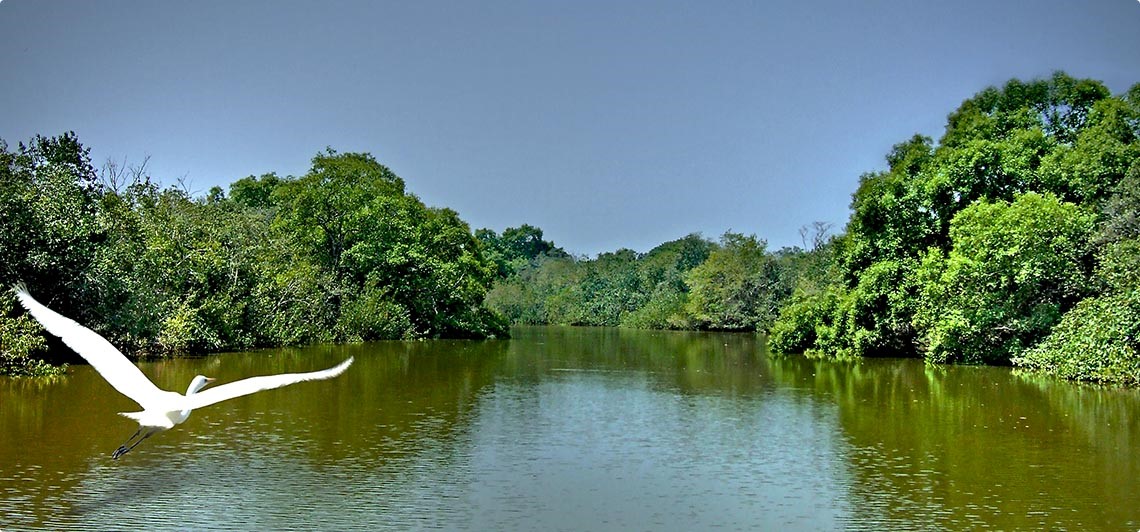Description

Disclaimer: Copyright infringement not intended.
Context: The number of winged guests flocking to the Bhitarkanika National Park has increased marginally this year, the census report of birds released by the forest department in Odisha said.
Details:
About:
- Bhitarkanika is India’s second largest mangrove ecosystem after the Sunderbans.
- The National park is essentially a network of creeks and canals which are inundated with waters from rivers Brahmani, Baitarani, Dhamra and Patasala forming a unique ecosystem.
- Bhitarkanika is home to the largest congregation of the endangered Salt Water Crocodiles in the country. The Salt Water Crocodile is the apex predator of the region, besides it, the park is home to numerous reptiles like the water monitor lizard, and pythons to name a few.
- Bhitarkanika is also home to numerous animals like the deer, hyenas, wild boar etc, and migratory birds which make it their home during the winter season lending a vibrant hue to the ecosystem.
- The other unique phenomenon is the Bagagahana or the heronry near Surajpore creek.
- Thousands of birds colonize the creek for nesting and the aerial acrobatics performed prior to the mating make for an impressive sight.
- Bhitarkanika is also home to eight varieties of Kingfisher birds which is also a rarity. The erstwhile hunting porch of the Maharaja adds to its heritage value.
Types of Forests in Odisha:
Forests are largely controlled by rainfall and temperature conditions of the region. Forests cover nearly 37 percent of the total area of the state. The presence of a large tribal population practicing shifting cultivation on an extensive scale engenders direct loss of valuable forest cover.
- The Northern Tropical Semi-Evergreen Region: This area is composed of a dense tree growth 24-36 meters high. The most striking feature of this region is the absence of bamboo growth. The tropical semi-evergreens are concentrated around Bonai between the Champaharam Pass and the Kurapadi stream of Bhagat Pass. They are also seen in the Redhakhol region because of its elevation ands precipitation.
- The Northern Tropical Moist Deciduous Region: This region accounts for almost 80 percent of the total forest cover in Odisha (Orissa). The Sal dominates region north and northeast of the Brahmani. It is also found to the east of the Tel river and in the Sabari basin. (Sal is the most valuable timber of Odisha (Orissa)). The Dendrocalamus stricts (Salia baunse) and Bamboosa arundinacea (Kanta baunsa) are the two dominant species that are found in the forests of the Eastern Ghats. They are confined to the Mahanadi and Rushikulya basins. The heterogeneous deciduous zone is the meeting ground of the Sal and other species like Adina Cardifolia (Kusum), the Xylia Xylocarpa, the Anogeissus Iatifolia (Dhau) and the Machilusvilloso.
- The Northern Tropical Dry Deciduous Region: The dry deciduous type is confined to the upper Tel, upper Nagavali and upper Sabari basins in the Western and South-Western parts of Odisha (Orissa). Here Sal and Bamboo thin out and teak pre-dominates.
- The Coastal Forests: The dense growth of palm and coconut with long thin stems, deep roots and a thin crown, has adapted itself nicely to the severe cyclones from the Bay of Bengal during the pre and post-monsoon periods. Creepers of varied species and canes and other minor types of trees have led to the description of the tidal forests of the Mahanadi mouth as the 'Little Sunderbans'. On the Puri coast, the Casuarina plantation has met the town's demand for fuel. In between the mangrove forest and the cultivated zone, a narrow strip of grassland extends from Chilka lake to the mouth of the Mahanadi and beyond.
.jpeg)
Protected Areas in Odisha:
|
National Parks
|
Biosphere Reserves
|
Wetlands
|
|
Bhitarkanika National Park
|
Simlipal Biosphere Reserve
|
Chilika Lagoon
|
|
Bhitarkanika Mangroves
|
|
Simlipal National Park
|
Satkosia Gorge
|

https://theprint.in/india/rise-in-seasonal-bird-count-in-bhitarkanika-national-park/1305703/












